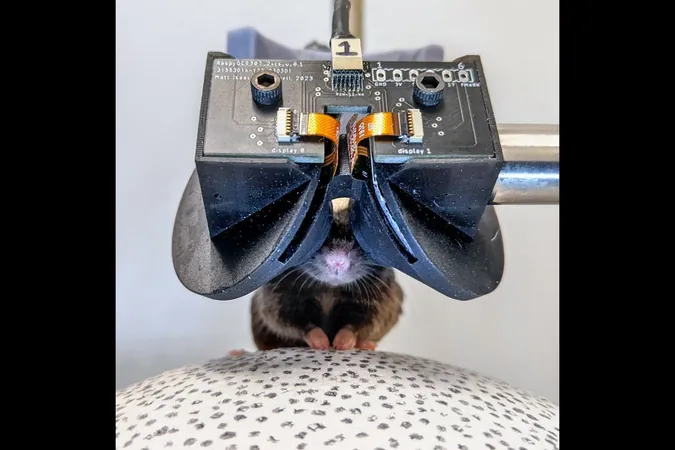
Miniature VR Goggles for Mice Revolutionize Scientific Research
2024-12-29
Author: Kai
Introduction
Have you ever imagined mice leaping into the future with virtual reality? Well, that’s no longer just a whimsical thought! Researchers at Cornell University have unveiled groundbreaking technology—adorably dubbed "MouseGoggles"—that allows our small furry friends to dive into immersive virtual experiences, marking a significant advancement in animal research methodology.
The Innovation
The innovation aims to enhance how scientists conduct experiments by simulating natural environments for mice in a controlled setting. Traditionally, experiments with mice involved cumbersome setups where the rodents were placed on treadmills surrounded by static screens that often failed to engage them fully. These limitations often resulted in delayed reactions to virtual stimuli, making it challenging to collect accurate data.
MouseGoggles: A Game Changer
The Cornell team’s creation of MouseGoggles is a game-changer! Instead of building an entirely new VR system, they ingeniously repurposed low-cost components from existing technology, particularly smartwatches, to create a miniature headset tailored for mice. This clever approach provided a perfect-sized display for optimal immersion, eliminating the need for lengthy design processes.
The Team's Vision
Lead scientist Matthew Isaacson highlighted the team’s innovative spirit by saying, “It benefited from the hacker ethos of taking parts that are built for something else and then applying it to some new context.” With easy access to the necessary components, the researchers were able to put together a dynamic VR experience for their tiny test subjects.
Experimental Trials
Through a series of experimental trials, Isaacson and his team monitored the mice's interactions with various stimuli while measuring their brain activity. The results were remarkable. In one test, a simulated dark blotch that resembled a potential predator elicited an immediate and startling response from the mice wearing the MouseGoggles—something that didn’t happen in previous setups. Isaacson noted, “When we tried this kind of test in the typical VR setup, the mice did not react at all. But with the goggles, they jumped, exhibiting a significant startle reaction.”
Implications of the Research
The implications of this pioneering research are vast. As scientists continue to refine VR for animal studies, the potential for understanding complex neurological conditions—like Alzheimer’s disease—grows exponentially. By creating accurate virtual environments, researchers hope to map critical brain activities related to spatial awareness and memory, ultimately paving the way for better treatments for brain disorders.
Conclusion
While the concept of mice enjoying VR might seem almost comical, it embodies a significant stride towards enhancing our understanding of animal behavior and brain function. The study was published in the prestigious journal Nature Methods, ensuring that the scientific community takes notice of this exciting development.
So, the next time you think about virtual reality, remember: it's not just for humans anymore—our furry friends are also getting in on the action! Stay tuned as we explore more remarkable innovations that change the way we conduct research and understand the world!



 Brasil (PT)
Brasil (PT)
 Canada (EN)
Canada (EN)
 Chile (ES)
Chile (ES)
 Česko (CS)
Česko (CS)
 대한민국 (KO)
대한민국 (KO)
 España (ES)
España (ES)
 France (FR)
France (FR)
 Hong Kong (EN)
Hong Kong (EN)
 Italia (IT)
Italia (IT)
 日本 (JA)
日本 (JA)
 Magyarország (HU)
Magyarország (HU)
 Norge (NO)
Norge (NO)
 Polska (PL)
Polska (PL)
 Schweiz (DE)
Schweiz (DE)
 Singapore (EN)
Singapore (EN)
 Sverige (SV)
Sverige (SV)
 Suomi (FI)
Suomi (FI)
 Türkiye (TR)
Türkiye (TR)
 الإمارات العربية المتحدة (AR)
الإمارات العربية المتحدة (AR)